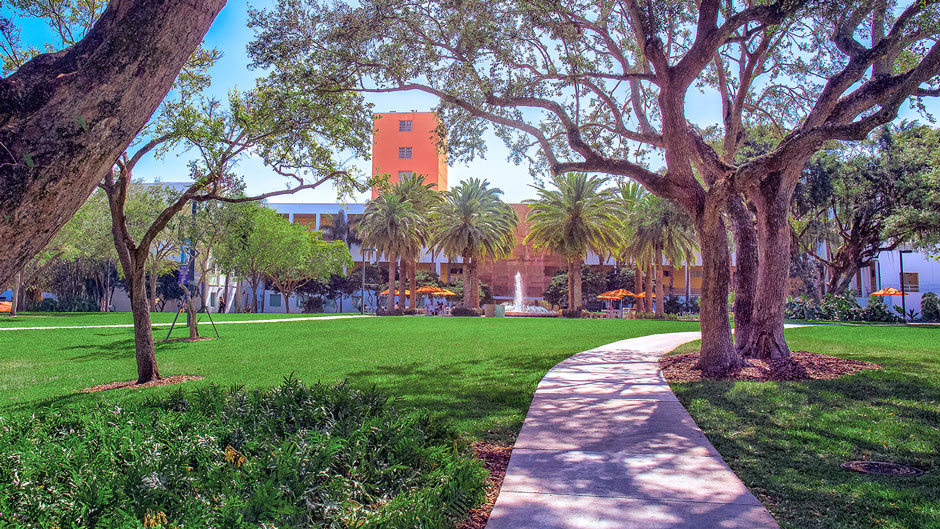In an effort to help students with disabilities at the University of Miami navigate campus life more efficiently and to facilitate more awareness about having a disability in college, a new student ambassador program is forming in partnership with the Office of Disability Services.
The Disability Ambassadors Program is currently seeking to be officially recognized by the Committee of Student Organizations (COSO). According to Mykel Billups, assistant dean of academic support at the Camner Center for Academic Resources and Office of Disability Services, the idea for the program stemmed from common challenges students would share with her about aspects of campus life and the need to build a sense of community among students with disabilities.
“I noticed the students were using their relationship with me as a way of telling me something that they’re having trouble with on campus that I might not notice,” said Billups. “So, I finally said we need to get together and have conversations about this–I needed them to tell me what was working and not working.”
The meetings at the Camner Center began about two years ago with then-students Ian Malesiewski, Carina Landgraf, and Billups and often were held with the Student Coalition for Disabilities working group, assembled by last year’s Student Government leadership.
Several students who currently are participating in the meetings are also involved with the Bridge Mentorship Program facilitated by Morgan Anderson, a learning specialist and assistant director for the University’s independent learning initiative. The Bridge program originally aimed to bring upper-class students with disabilities together with newer students as a means of helping them have a smoother transition to college despite their impairments.
“I think the Camner Center does such an excellent job in supporting those students in an academic way, but what we’ve seen over the years is there isn’t really a social aspect,” Anderson said. “Dr. Billups was working with them and, because of the work that I do, she asked me if I wanted to get involved and I said yes, of course. So, we held an open house back in April and kind of presented the idea of an ambassador program, and there were a lot of people interested.”
Since its inception, students have been working diligently over the summer to discuss the logistics of the ambassador program. They also have been constructing a pitch and constitution to present to the COSO to get the organization officially recognized and registered by the University.
The aim of this new program, according to Billups, is similar to that of the Bridge Mentorship Program but the student ambassadors will be a resource as well as mentors for incoming students with disabilities. They will offer information, support, and be role models for the students transitioning to college. These more seasoned students can share tips to navigate accessibility points around campus, help the newer students manage their work at a level that is best suited for them, and generally give advice that can help the others to quickly adjust to the many facets of life on campus.
“Oftentimes, we get students and parents who would like to hear from a student who already went through the process of accessing accommodations,” Billups said. “The benefits of a student-to-student conversation would have more impact in developing a peer support network for a new student. A disability ambassador can help students understand the process and provide reassurance about what's going on to help relieve some of the added stressors that go along with the transition to a new place.”
Some students with disabilities, such as sophomore Onelia Mendive who helped launch the Bridge program, noted that their own experiences of transitioning into college life inspired them to join the new organization.
“I think the accommodations are good, but mainly good academically,” said Mendive. “You aren’t prepared for the social aspect of college and just how much it takes a toll on you. I can say for me, personally, it was just very exhausting at first to get into college.”
Naturally, having students who identify as having a disability as the face of the new organization is a priority of both the advisors and students involved. According to Billups and Anderson, the goal is to have at least 50 percent of the students on the executive board identify as someone with a disability.
“I have a friend that’s a part of the organization and they were reaching out to me saying that I have to see this super cool club. It’s something super unique that no one’s ever done on campus,” said Veronica Gilbert, a senior majoring in health sciences on the pre-med track. “I do not identify [as a student with a disability], but I think that's one of the cool pieces of this club is how you can have this mix of diversity in leadership positions.”
Given the program’s inclusivity of all students, the advisors and students involved hope to facilitate more discussions about disability with others who have limited knowledge about dealing with disabilities and accessibility at college.
Whether their limitations are mental or physical, students with disabilities often require a combination of accommodations and adjustments specific to their needs, and this program aims to provide support while also educating the University community and beyond.
“We want to educate people about disabilities, but we also want to make sure to try and make the school a better place for students with disabilities,” said Mendive.

